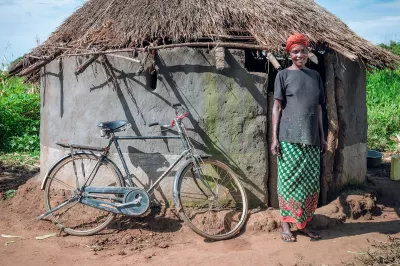Last-Mile Consumer Finance: Embracing Opportunity, Managing Risk
Four years ago, Bindu Devi attended a training in Uttar Pradesh from an organization called Dharma Life that works to alleviate poverty through rural entrepreneurship. She liked the organization, which was establishing its roots in rural India. She became a Dharma Life Entrepreneur (DLE) and began generating income by selling products such as induction cookstoves to her community members.
Today, Bindu is one of more than 17,000 DLEs, 75 percent of them women, who work with Dharma Life to expand affordable access to impactful goods and services in rural India. DLEs also engage in awareness generation activities around social issues and conduct research and data collection on behalf of Dharma Life. Increasingly, they are becoming a pivotal access point to consumer finance and potentially other financial services.

High-value, quality products such as cookstoves, water purifiers and solar systems are not always available and affordable to people in rural areas. Dharma Life and other last-mile distributors (LMDs) aim to bridge this gap by developing efficient rural distribution networks and offering a range of life-enhancing products. Yet even with Dharma Life’s network of rural entrepreneurs, many products are still too expensive for people in those communities. Dharma Life has partnered with microfinance institutions (MFIs) to extend consumer finance, but many customers are not clients of an MFI. To address last-mile affordability for its poorest clients, Dharma Life has taken the next step: financing sales on its own balance sheet.
This takes them into the realm of financial services, requiring them to manage risk. Dharma Life is not alone in taking this step. A survey by the Global Distributors Collective in 2019 found that 69 percent of LMDs around the world finance their own sales of life-enhancing products, with 48 percent of all sales being financed. The same report also shows that LMDs’ customers are extremely poor: three quarters of all LMD customers live on less than $3.20 a day.
On the one hand, this means LMDs are reaching poor people with critical financing; Bindu told us that her sales have more than tripled since customers started buying on credit. On the other hand, it means they need to rapidly develop risk management capabilities to ensure that they can sustainably lend to these customers.
Credit risk at Dharma Life
To enable consumer financing, Dharma Life negotiates credit terms with product partners which they then pass onto DLEs like Bindu, who then allow customers to pay for a cookstove or other products in three to four installments over several weeks. Currently, this process is decentralized: the consumer’s creditworthiness is determined by a standard set of questions along with the DLE’s knowledge and understanding of the local context.
While they have the benefit of tapping into local knowledge and understanding, there are also risks associated with this type of assessment. Maintaining consistency in data collection is a challenge, and relying on DLEs' judgement means that Dharma Life does not always have a complete understanding of the lending context.
As Dharma Life and other LMDs grow their operations and offer higher-value products, there is a need to better manage risk through increased transparency, better process tracking, and mechanisms to ensure accountability throughout the organization. CGAP’s work with IPC and Dharma Life identified the following as key areas requiring attention as Dharma Life builds out its consumer finance portfolio:
- Standardize and digitize credit-related processes from Dharma Life to DLEs and from DLEs to end-customers. Digitizing processes like sourcing, application, assessment and repayments will improve data gathering, which will enable more process automation and data-based decision making.
- Systematize DLE training around credit. As DLEs offer higher-value products to their customers, Dharma Life is required to ensure they can accurately assess the character and creditworthiness of customers. This will require in-depth and repeated training in credit assessment, digital credit tools, collections and related topics.
- Establish an internal control unit to ensure oversight. It is no longer sufficient for Dharma Life to manage risk on the frontlines. An internal risk management function would provide an independent perspective on the organization’s activities and ensure risks being taken are within the organization’s stated appetite and limits.
Questions about the future of risk management at Dharma Life and other LMDs
When do we become too centralized? As LMDs move to credit processes that are more streamlined and data driven, it will be interesting to see how they capture and incorporate local entrepreneurs’ nuanced understanding of the local context and people into the decision-making process. At Dharma Life, technology should enhance DLEs' ability to capture the qualitative data that is central to the organization and enable them to better serve the needs of rural communities across India. But this will depend heavily on how well digital solutions are designed and implemented.
What are the right incentive structures to mitigate risk? The search for a balance between scale and sustainability is a familiar one to many asset finance companies and microfinance institutions. Dharma Life is no exception. It must balance its commitment to improving rural poor people’s access to affordable products with its need to ensure portfolio quality, in the long run and at scale. To do this, incentives need to be designed and checks put in place to ensure DLEs are acting responsibly in extending credit to their customers. As entrepreneurs, DLEs want to maximize earnings. Without the right incentives in place, consumer finance could lead them to push products that are not well suited to the customers or encourage behavior that could result in clients becoming overindebted.
Looking ahead
For Bindu, consumer finance has been a net positive, increasing her income and connections within her community. When customers miss payments, she visits them at their house to check on them, and sometimes uses her own savings to help them. According to her, working with Dharma Life has “not only helped me earn money, but also widened my mental horizon.”
It will be instructive to follow Dharma Life and other LMDs as they leverage their entrepreneur networks to extend credit while effectively managing risk. If successful, LMDs can serve as an entry point for potentially life-enhancing financial services, such as digital payments, microinsurance, savings and investment.
Want to learn more about how to manage credit risk in asset finance? Check the technical guide for credit risk managers and senior executives at asset finance companies, and the recording of our recent webinar on this topic.
Resources
From Sub-Saharan Africa to the Indian Subcontinent, asset finance and leasing companies are doing invaluable, innovative work to finance critical assets for low-income and informal borrowers.
From Sub-Saharan Africa to the Indian sub-continent, asset finance and leasing companies are doing innovative work to finance solar home systems, smartphones, motorbikes, and other critical assets. These companies provide credit to low-income and informal borrowers who are traditionally underserved by formal financial institutions. But many are new to lending and do not always have deep experience in organizing a credit operation, mitigating risk throughout a credit transaction, or managing a portfolio of loans or leases.




Add new comment